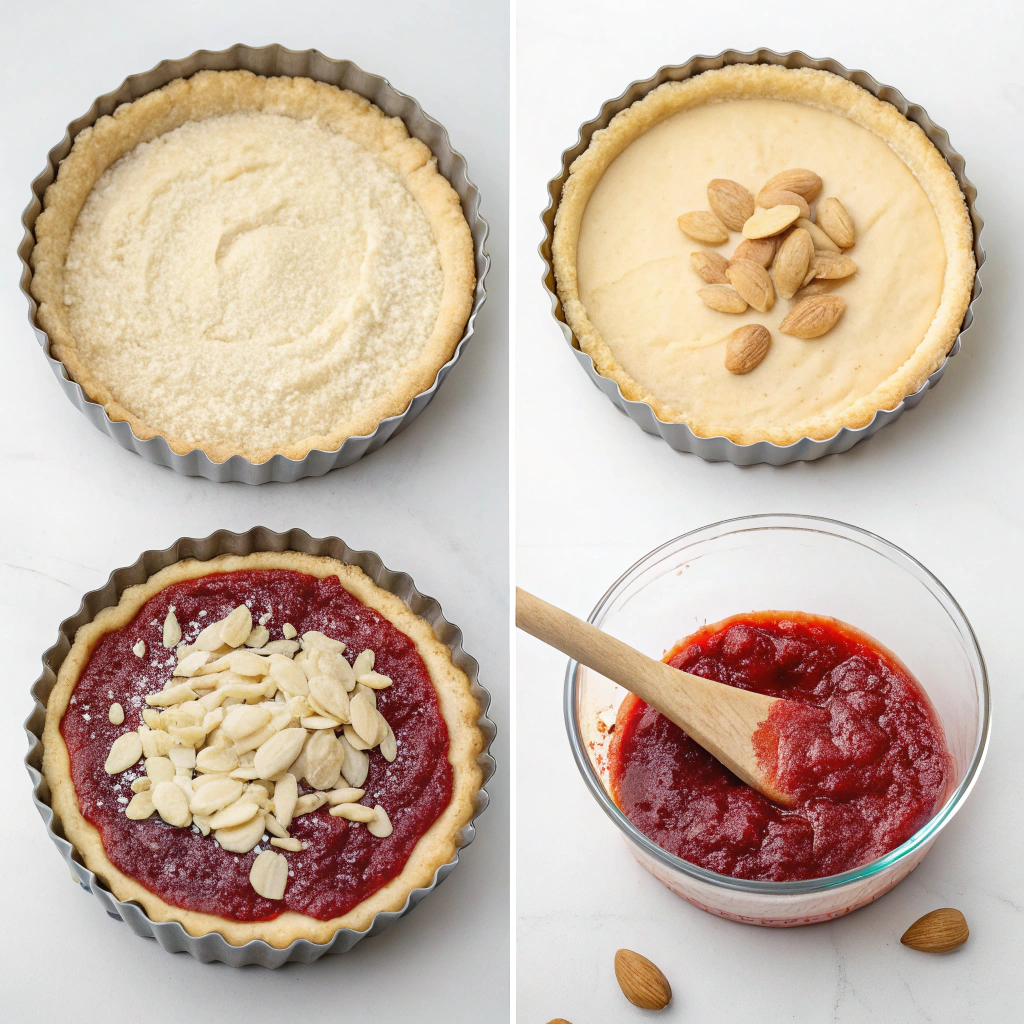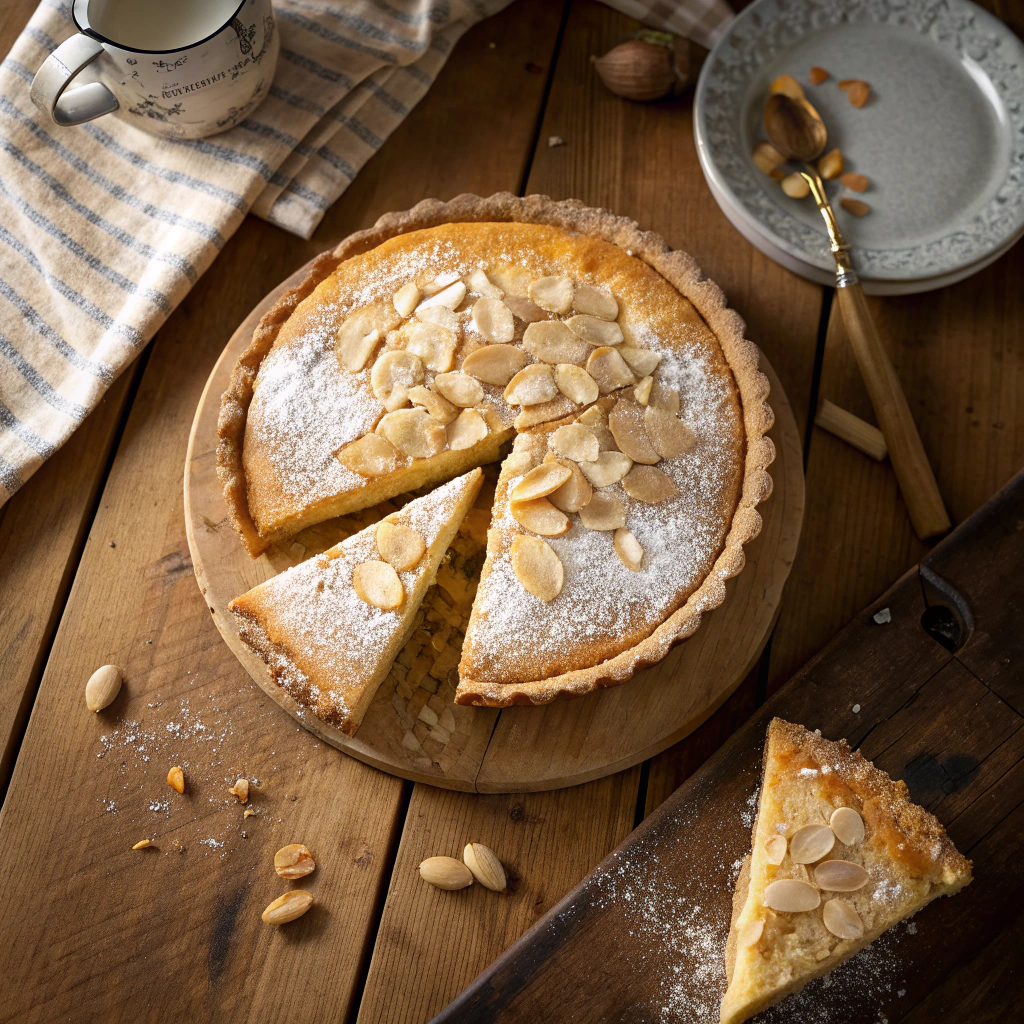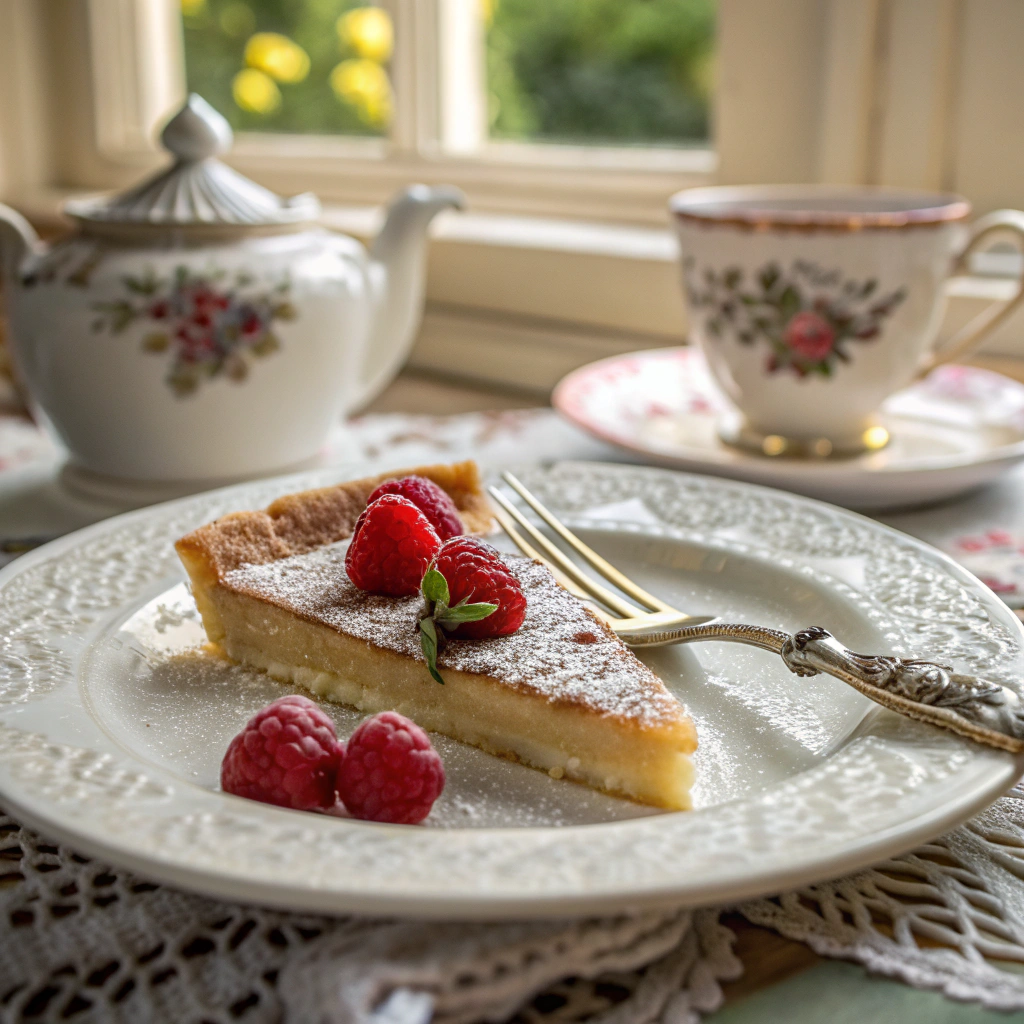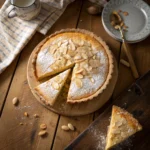Transport yourself to the charming market town of Bakewell in Derbyshire, where a kitchen accident in the 1860s created one of Britain’s most beloved desserts – the classic British Bakewell tart. This delightful confection, with its buttery pastry base, layer of raspberry jam, and rich almond frangipane topping, has become synonymous with traditional British afternoon tea and home baking excellence.
Many home bakers struggle with soggy pastry, uneven frangipane, or overly sweet results when attempting this classic British Bakewell tart. The combination of achieving the perfect pastry texture while balancing the sweet almond filling with tart raspberry jam requires precise technique and understanding of traditional methods. For more insights into this fascinating dessert’s origins, the Derbyshire Times’ historical account of Bakewell pudding origins provides excellent background context.
Today, you’ll master the authentic techniques for perfect pastry, balanced flavors, and professional presentation that will transform your classic British Bakewell tart from kitchen experiment to show-stopping dessert. With proper guidance and traditional methods, you’ll create a tart that would make any Derbyshire baker proud.
Table of Contents
The History and Heritage of Classic British Bakewell Tart
The story of the classic British Bakewell tart begins in the picturesque market town of Bakewell, nestled in the heart of Derbyshire’s Peak District. Legend tells of a kitchen mishap in the 1860s at the White Horse Inn (now the Rutland Arms Hotel), where a cook accidentally spread egg mixture intended for pastry over a layer of jam instead of mixing it properly into the base.
This happy accident created what we now know as the Bakewell pudding, the predecessor to our beloved Bakewell tart. The original pudding featured a puff pastry base with jam and a rich, custard-like almond filling that was much looser than today’s frangipane. The official Bakewell Pudding Shop history documents how this serendipitous mistake became a local specialty.
The evolution from Bakewell pudding to the modern Bakewell tart occurred gradually throughout the late 19th and early 20th centuries. Bakers began using shortcrust pastry instead of puff pastry, creating a sturdier base that could support the weight of the almond filling. The custard-like filling was replaced with frangipane – a firmer almond cream that sliced cleanly and transported better.
Regional Variations Across Britain
While Derbyshire claims the original, regional variations of the classic British Bakewell tart have emerged across Britain. Northern England tends to favor a thicker layer of jam, often using locally-made preserves. Scottish versions sometimes incorporate oatmeal into the pastry for added texture, while Welsh bakers have been known to add a hint of honey to the frangipane filling.
The traditional almond topping varies regionally too – some areas prefer flaked almonds, others use whole blanched almonds, and certain regions dust with icing sugar for a more refined presentation. These variations reflect local tastes and available ingredients, but all maintain the essential elements that define an authentic Bakewell tart.
Essential Ingredients for Authentic Bakewell Tart Success
Creating an exceptional classic British Bakewell tart requires careful attention to ingredient quality and selection. Each component plays a crucial role in achieving the perfect balance of flavors and textures that defines this traditional dessert.
Quality Ground Almonds vs Almond Flour
The foundation of authentic frangipane lies in using proper ground almonds rather than commercial almond flour. Ground almonds retain more of their natural oils and provide the rich, moist texture essential for traditional Bakewell tart filling. Almond flour, while convenient, is often too fine and can create a dry, cake-like texture that lacks the characteristic density of proper frangipane.
For best results, choose ground almonds with visible texture rather than powder-fine consistency. The slightly coarser grind provides better moisture retention and creates the authentic mouthfeel expected in a classic British Bakewell tart. Store ground almonds in the refrigerator to maintain freshness and prevent the natural oils from becoming rancid.
Choosing the Right Raspberry Jam
Traditional Bakewell tart relies on high-quality raspberry jam with a good fruit-to-sugar ratio. Avoid overly sweet, commercial jams that can overwhelm the delicate almond flavors. Look for preserves with at least 50% fruit content and visible raspberry pieces for authentic texture and tartness that balances the rich frangipane.
Seedless raspberry jam works well for those who prefer smoother textures, but traditional recipes often embrace the rustic appeal of seeds. Some bakers prefer to use homemade jam or high-end artisanal preserves for superior flavor depth. The jam layer should provide a pleasant contrast to the sweet almond filling without dominating the overall taste profile.
| Ingredient | Quality Markers | Storage Tips |
|---|---|---|
| Ground Almonds | Visible texture, fresh aroma, pale color | Refrigerate, use within 3 months |
| Raspberry Jam | 50%+ fruit content, visible pieces | Cool, dry place after opening |
| Butter | Unsalted, European-style preferred | Room temperature for mixing |
| Plain Flour | Protein content 10-12% | Airtight container, cool location |
Butter Temperature Importance
Butter temperature significantly impacts both pastry and frangipane success. For pastry, butter should be cool but pliable – not soft enough to be greasy but workable without excessive force. For frangipane, room temperature butter creates the light, creamy texture essential for proper mixing and baking.
Step-by-Step Classic British Bakewell Tart Recipe with Professional Techniques
This comprehensive recipe guide will walk you through creating an authentic classic British Bakewell tart using traditional techniques refined by generations of British bakers. Each step includes professional tips to ensure consistent, bakery-quality results.
Perfect Pastry Preparation and Chilling
Ingredients for Pastry:
| 225g (8oz) plain flour 115g (4oz) cold unsalted butter, cubed 25g (1oz) caster sugar 1 large egg yolk 2-3 tablespoons cold water Pinch of salt |
Begin by rubbing the cold butter into flour and salt until the mixture resembles fine breadcrumbs. This technique, known as the rubbing-in method, creates the flaky texture essential for proper shortcrust pastry. Work quickly to prevent the butter from warming and becoming greasy.
Add the sugar and mix briefly before creating a well in the center. Combine the egg yolk with cold water and gradually add to the flour mixture, mixing with a fork until the dough just comes together. Avoid overworking, which develops gluten and creates tough pastry.
Form the dough into a flat disc, wrap in plastic film, and chill for at least 30 minutes. This resting period allows the gluten to relax and the butter to firm up, making the pastry easier to roll and less likely to shrink during baking.

Blind Baking for Crispy Base
Roll the chilled pastry on a lightly floured surface to 3mm thickness and line a 23cm (9-inch) tart tin. Trim excess pastry, leaving a small overhang, and crimp the edges decoratively. Prick the base all over with a fork to prevent puffing during blind baking.
Line the pastry with parchment paper and fill with baking beans or ceramic weights. This technique, essential for classic British Bakewell tart success, prevents the pastry from rising and ensures a crisp base that won’t become soggy under the jam and frangipane layers.
Bake at 190°C (375°F/Gas 5) for 15 minutes, then remove the weights and parchment. Return to the oven for 5-8 minutes until the base is lightly golden and set. This partial baking creates the perfect foundation for your tart.
Creating Smooth Frangipane Filling
Frangipane Ingredients:
| 115g (4oz) unsalted butter, softened 115g (4oz) caster sugar 2 large eggs 115g (4oz) ground almonds 1 tablespoon plain flour 1/2 teaspoon almond extract |
Cream the softened butter and sugar until pale and fluffy – this takes about 3-4 minutes with an electric mixer. Properly creamed butter incorporates air, creating the light texture characteristic of quality frangipane.
Add eggs one at a time, beating well after each addition. If the mixture appears to curdle, add a tablespoon of the ground almonds and continue mixing. Fold in the remaining ground almonds, flour, and almond extract using a large metal spoon to maintain the airy texture.
Assembly and Baking Techniques
Spread 3-4 tablespoons of high-quality raspberry jam evenly over the cooled pastry base, leaving a small border around the edges. The jam layer should be generous enough to provide flavor contrast but not so thick that it overwhelms the delicate almond filling.
Carefully spoon the frangipane mixture over the jam, spreading gently to avoid disturbing the jam layer. Level the surface with a palette knife and sprinkle with flaked almonds for traditional presentation.
Bake at 180°C (350°F/Gas 4) for 30-35 minutes until the frangipane is golden brown and set in the center. The filling should spring back lightly when touched and pull slightly away from the pastry edges. Allow to cool completely before slicing for clean, professional-looking portions.
For those interested in exploring more traditional British-inspired pie recipes, the techniques learned here apply beautifully to other classic desserts. The BBC Food’s traditional Bakewell tart guide offers additional professional insights for perfecting your technique.
Troubleshooting Common Classic British Bakewell Tart Problems

Even experienced bakers encounter challenges when perfecting their classic British Bakewell tart technique. Understanding common problems and their solutions ensures consistent success with this beloved traditional dessert.
Preventing Soggy Pastry Base
Soggy pastry represents the most common issue in Bakewell tart preparation. This occurs when moisture from the jam layer penetrates insufficiently baked pastry. Ensure your pastry base is completely cooked during blind baking – it should be pale golden and feel dry to the touch.
Create a moisture barrier by brushing the baked pastry base with beaten egg white while still warm. This technique, used by professional bakers, creates an invisible seal that prevents jam moisture from penetrating the pastry. Allow the egg white to dry completely before adding jam.
Temperature control also plays a crucial role. Ensure the pastry base is completely cool before adding jam, and avoid using jam that’s too runny or contains excess liquid. If your jam seems thin, cook it briefly in a saucepan to reduce moisture content.
Avoiding Curdled Frangipane
Curdled frangipane results from temperature differences between ingredients or adding eggs too quickly to cold butter. Always ensure butter reaches proper room temperature – it should give slightly when pressed but not be greasy or melted.
Add eggs gradually, one at a time, beating thoroughly between additions. If curdling occurs, add a tablespoon of flour or ground almonds and continue mixing. The mixture will usually come together with persistent mixing. In extreme cases, gently warm the bowl while mixing to bring ingredients to similar temperatures.
Achieving Even Browning
Uneven browning often indicates oven hot spots or incorrect positioning. Place your classic British Bakewell tart on the middle rack for optimal heat circulation. If browning occurs too quickly, reduce temperature by 10°C and cover loosely with foil.
Rotating the tart halfway through baking ensures even color development. Some ovens benefit from using a pizza stone or heavy baking sheet placed on the bottom rack to create more even heat distribution.
Bakewell Tart Variations and Modern Adaptations
While traditional raspberry jam defines the classic British Bakewell tart, creative variations allow home bakers to explore different flavor combinations while maintaining the essential character of this beloved dessert.
Different Jam Flavors and Combinations
Apricot jam creates a mellower, more subtle flavor that pairs beautifully with almond frangipane. Blackberry jam offers deeper, more complex berry notes, while strawberry provides familiar sweetness. More adventurous bakers might try damson plum or cherry jam for unique regional variations.
Citrus marmalades, particularly orange or lemon, create sophisticated adult versions of the classic British Bakewell tart. The slight bitterness balances the sweet almond filling perfectly. Some modern interpretations combine two jams – perhaps raspberry and apricot – for complex flavor profiles.
Gluten-Free Adaptations
Gluten-free versions maintain authentic flavor while accommodating dietary requirements. Replace plain flour in pastry with gluten-free flour blend (1:1 ratio) plus 1/2 teaspoon xanthan gum if not already included. The frangipane adapts easily – simply substitute the tablespoon of plain flour with ground almonds or gluten-free flour.
Rice flour or almond flour work particularly well in gluten-free pastry, creating tender textures similar to traditional versions. Allow extra chilling time for gluten-free pastry, as it benefits from longer rest periods.
| Variation | Key Changes | Flavor Profile |
|---|---|---|
| Individual Tarts | Reduce baking time to 20-25 minutes | Perfect portion control |
| Seasonal Fruit | Add fresh berries to frangipane | Enhanced fruit flavors |
| Chocolate Twist | Add 2 tbsp cocoa to frangipane | Rich, indulgent variation |
| Citrus Version | Add lemon zest to filling | Bright, fresh notes |
Those who enjoy experimenting with dessert variations might also appreciate popular British dessert variations that showcase similar traditional baking techniques in different formats.
Storage, Serving, and Presentation Tips
Proper storage and serving techniques ensure your classic British Bakewell tart maintains optimal flavor and texture while presenting beautifully for any occasion.
Proper Storage Methods and Duration
Store completed Bakewell tart covered at room temperature for up to 3 days or refrigerated for up to 5 days. The frangipane filling actually improves in flavor after the first day, as the almond and jam flavors meld together. Avoid storing in airtight containers immediately after baking, as trapped steam can soften the pastry.
For longer storage, wrap individual slices in plastic film and freeze for up to 3 months. Thaw frozen portions at room temperature for 2-3 hours before serving. The texture remains remarkably close to fresh when properly frozen and thawed.
Serving Temperature Recommendations
Serve classic British Bakewell tart at room temperature for optimal flavor development. Cold tart masks the delicate almond flavors, while warm serving can make the filling too soft for clean slicing. Allow refrigerated tart to reach room temperature for 30-45 minutes before serving.
During summer months, slightly chilled tart provides refreshing contrast to warm weather, but avoid serving directly from refrigeration. The ideal serving temperature enhances both flavor and texture without compromising structural integrity.
Presentation and Garnishing
Traditional presentation features a light dusting of icing sugar just before serving. This classic touch adds visual appeal without overwhelming the existing flavors. Fresh raspberries arranged around individual slices create beautiful color contrast and hint at the jam layer within.
For special occasions, a drizzle of simple icing made from icing sugar and lemon juice adds elegant finishing touches. Some bakers prefer toasted flaked almonds as garnish, emphasizing the almond theme while adding textural interest.

Frequently Asked Questions
How long does a classic British Bakewell tart last after baking?
A properly stored classic British Bakewell tart maintains excellent quality for 3-4 days at room temperature or up to 5 days refrigerated. The frangipane filling actually develops richer flavors after the first day as ingredients meld together. Store covered with a clean tea towel or loose plastic wrap to prevent drying while allowing air circulation. For optimal texture, avoid airtight containers during the first 24 hours after baking.
Can I make Bakewell tart frangipane filling ahead of time?
Yes, frangipane for classic British Bakewell tart can be prepared up to 2 days in advance and stored covered in the refrigerator. Allow the mixture to return to room temperature before using, and give it a gentle stir to restore smooth consistency. This advance preparation actually benefits flavor development and makes assembly much quicker on baking day. The pastry can also be blind-baked a day ahead and stored covered at room temperature.
What’s the difference between Bakewell tart and Bakewell pudding?
While both originate from Bakewell, Derbyshire, the classic British Bakewell tart uses shortcrust pastry and firm frangipane filling that slices cleanly. Bakewell pudding features puff pastry with a softer, more custard-like almond filling that’s spooned rather than sliced. The tart evolved from the pudding during the late 19th century to create a more portable and practical dessert. Both maintain the essential raspberry jam and almond combination that defines the Bakewell flavor profile.
Why is my Bakewell tart pastry base always soggy?
Soggy pastry in classic British Bakewell tart typically results from insufficient blind baking or moisture penetration from the jam layer. Ensure your pastry base is completely baked – it should be pale golden and feel dry to touch. Create a moisture barrier by brushing the warm, baked pastry with beaten egg white before cooling. Use thick, high-quality jam rather than runny preserves, and ensure the pastry base is completely cool before assembly.
Can I substitute the ground almonds in traditional Bakewell tart recipe?
While ground almonds are essential for authentic classic British Bakewell tart flavor, you can substitute with ground hazelnuts for a different but delicious variation. Avoid substituting with flour or other non-nut alternatives, as this fundamentally changes the character of frangipane. For those with tree nut allergies, sunflower seed flour provides similar texture, though the flavor profile differs significantly. Always maintain the same quantity ratios when substituting to preserve proper texture.
What temperature should I serve my British Bakewell tart?
Serve classic British Bakewell tart at room temperature for optimal flavor and texture. Cold serving masks the delicate almond flavors, while warm serving can make slicing difficult as the frangipane becomes too soft. If stored refrigerated, allow 30-45 minutes at room temperature before serving. During hot weather, slightly chilled is acceptable, but avoid serving directly from refrigeration. Room temperature allows all flavors to shine while maintaining structural integrity for clean slicing.
Conclusion
Mastering the classic British Bakewell tart requires attention to traditional techniques, quality ingredients, and proper timing, but the results justify every careful step. The combination of crisp pastry, tart raspberry jam, and rich almond frangipane creates a dessert that embodies the best of British baking heritage.
Key success factors include achieving proper pastry texture through careful butter temperature control, preventing soggy bases with thorough blind baking, and creating smooth frangipane through gradual ingredient incorporation. Quality ingredients – particularly ground almonds and good raspberry jam – make significant differences in final flavor and authenticity.
Whether served for traditional afternoon tea, family gatherings, or special occasions, your homemade classic British Bakewell tart connects you to generations of British baking tradition. The techniques mastered here will serve you well in other traditional desserts, and for those planning family-friendly British dessert portions, individual tart versions work beautifully for packed lunches or children’s parties.
Take confidence in these time-tested methods, embrace the wonderful accident that created this beloved dessert, and enjoy sharing your authentic classic British Bakewell tart with family and friends. Each slice carries forward the charming story of Derbyshire’s famous kitchen mishap that became Britain’s treasured teatime tradition.
Print
Classic British Bakewell Tart Recipe: Authentic Almond & Jam Delight
- Total Time: 2 hours 35 minutes
- Yield: 8 servings 1x
- Diet: Vegetarian
Description
This authentic British Bakewell Tart is a timeless classic that combines buttery shortcrust pastry, tangy raspberry jam, and rich almond frangipane filling topped with flaked almonds. Named after the town of Bakewell in Derbyshire, this elegant dessert strikes the perfect balance between sweet and tart flavors with a delightfully moist texture. While it requires a bit of patience with chilling and blind baking, the results are absolutely worth it for this show-stopping British teatime favorite.
Ingredients
- For the Pastry:
- 140g (1 cup) all-purpose flour
- 70g (¼ cup + 2 tbsp) unsalted butter, cold and cubed
- 35g (3 tbsp) icing sugar
- 1 large egg yolk
- 1–2 tbsp ice water
- For the Filling:
- 175g (½ cup) good quality raspberry jam
- 115g (½ cup) unsalted butter, softened
- 115g (½ cup) caster sugar
- 2 large eggs
- 140g (1¼ cups) ground almonds
- 1 tsp almond extract
- 2 tbsp all-purpose flour
- For Finishing:
- Flaked almonds for topping
- Icing sugar for dusting
Instructions
- Make the Pastry: In a food processor, pulse flour, cold cubed butter, and icing sugar until mixture resembles coarse breadcrumbs. Add egg yolk and pulse until dough begins to clump. If too dry, add ice water 1 tablespoon at a time until dough comes together.
- Chill the Dough: Turn dough onto floured surface, shape into a disk, wrap in plastic wrap, and refrigerate for 2 hours.
- Prepare for Baking: Preheat oven to 180°C (350°F). Roll out chilled pastry on floured surface and carefully line a 23cm (9-inch) tart tin. Trim excess pastry.
- Blind Bake the Pastry: Prick base with fork, line with parchment paper, fill with baking beans or rice, and blind bake for 15 minutes. Remove paper and beans, bake 5 more minutes until lightly golden. Let cool slightly.
- Add the Jam Layer: Evenly spread raspberry jam over the cooled pastry base.
- Make the Frangipane: Beat softened butter and caster sugar until light and fluffy. Beat in eggs one at a time, scraping down sides. Stir in ground almonds, almond extract, and flour until smooth.
- Assemble the Tart: Carefully spread frangipane mixture over jam layer. Sprinkle evenly with flaked almonds.
- Bake to Perfection: Bake for 30-35 minutes until golden brown and springy to touch.
- Cool and Serve: Cool completely in tin before removing. Dust with icing sugar just before serving.
Notes
Essential Tips: Keep butter cold when making pastry for the flakiest texture. Don’t skip the 2-hour chill time – it prevents shrinkage during baking. Blind Baking: This pre-baking step ensures a crisp bottom crust that won’t go soggy under the jam and frangipane. Quality Matters: Use good quality raspberry jam for the best flavor balance. Seedless jam works well for a smoother texture. Storage: Keeps covered at room temperature for 3 days or refrigerated for up to 1 week. Variations: Try strawberry or apricot jam for different flavor profiles, or add lemon zest to the frangipane for extra brightness.
- Prep Time: 30 minutes
- Cook Time: 35 minutes
- Category: Dessert
- Method: Baking
- Cuisine: British
Nutrition
- Serving Size: 1 slice (1/8th of tart)
- Calories: 420
- Sugar: 28g
- Sodium: 120mg
- Fat: 24g
- Saturated Fat: 10g
- Unsaturated Fat: 12g
- Trans Fat: 0g
- Carbohydrates: 45g
- Fiber: 3g
- Protein: 8g
- Cholesterol: 85mg

